| Top Ten Essential Architecture | top ten islamic buildings | |||||||||||||
.jpg) |
||||||||||||||
| For a more complete list, see islamic architecture | ||||||||||||||
| 1 | The Taj Mahal in Agra | |||||||||||||
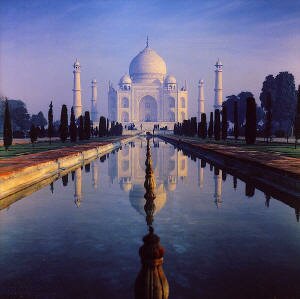 |
The Tāj Mahal (Hindi: ताज महल) is a mausoleum located in Agra, India. The Mughal Emperor Shāh Jahān commissioned it as a mausoleum for his favourite wife, Mumtaz Mahal. Construction began in 1632 and was completed in 1648. Some dispute surrounds the question of who designed the Taj; it is clear a team of designers and craftsmen were responsible for the design, with Ustad Isa considered the most likely candidate as the principal designer. The Taj Mahal (sometimes called "the Taj") is generally considered the finest example of Mughal architecture, a style that combines elements of Persian, Indian and Islamic architecture. While the white domed marble mausoleum is the most familiar part of the monument, the Taj Mahal is actually an integrated complex of structures. It was listed as a UNESCO World Heritage Site in 1983 when it was described as a "universally admired masterpieces of the world's heritage".[ |
|||||||||||||
| 2 | The Dome of the Rock, Jerusalem | |||||||||||||
 |
The Dome of the Rock (Arabic:, translit.: Qubbat As-Sakhrah, translit.: Kipat Hasela, Turkish: Kubbetüs Sahra) is a notable Islamic shrine for pilgrimage in what Muslims call masjid al-Aqsa or the Noble Sanctuary (al-Haram al-Qudsi al-Sharif) — which Jews and Christians call Har ha-Bayit or the Temple Mount — it remains one of the best known landmarks of Jerusalem. It was built between 687 and 691 by the 9th Caliph, Abd al-Malik. It is often mistakingly referred to as Mosque of Umar, the actual mosque of Caliph Umar ibn al-Khattab residing next to the Church of the Holy Sepulchre. |
|||||||||||||
| 3 | The Hagia Sofia in Istanbul | |||||||||||||
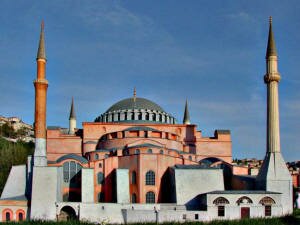 |
Hagia Sophia, (the Church of) Holy Wisdom, now known as the Ayasofya Museum, is a former Eastern Orthodox church converted to a mosque in 1453 by the Turks, and converted into a museum in 1935. It is located in Istanbul, Turkey. It is traditionally considered one of the great buildings in history. Its conquest by the Ottomans at the fall of Constantinople is considered one of the great tragedies of Christianity by the Greek Orthodox faithful. The name comes from the Greek name Ἁγία Σοφία, a contraction of Ναός τῆς Ἁγίας τοῦ Θεοῦ Σοφίας, meaning "Church of the Holy Wisdom of God". It is also known as Sancta Sophia in Latin and Ayasofya in Turkish. Although it is sometimes called "Saint Sophia" in English, it is not named after a saint named Sophia — the Greek word sofia means "wisdom." |
|||||||||||||
| 4 | The Isfahan, Maydan-i-Shah Mosque in Isfahan, Iran | |||||||||||||
 |
The maidan, or public plaza, is an eight hectare space constructed under Shah Abbas I between 1590 and 1595 for state ceremonies and sport. A two storied, arcaded perimeter of stores was added by 1602 in an effort to introduce commerce to the area, luring merchants from the old city to the north. |
|||||||||||||
| 5 | The interior view of the Mezquita, Cordoba, Spain | |||||||||||||
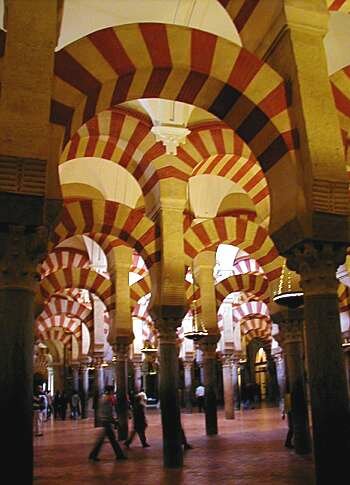 |
The Mezquita (Spanish for "mosque", from the Arabic مسجد "Masjid") is a Roman Catholic cathedral in Córdoba, Spain. It was originally built to be a warehouse/temple/lighthouse. It later became the second-largest mosque in the world. The construction of the Mezquita started in approximately sixth century A.D. as a Christian Visigothic church. Later, the Mezquita (originally the Aljama Mosque) was reworked for over two centuries to refashion it as a mosque, starting in 784 A.D. under the supervision of the first Muslim Emir Abd ar-Rahman I, who used it as an adjunct to his palace and named it to honor his wife. The land was bought by the Emir from the previous owners. It is believed that the site included the Visigothic cathedral of St. Vincent. When the forces of Tariq ibn-Ziyad first occupied Córdoba in 711, the Christian cathedral was suppressed. Several explanations have been proposed to explain the mosque's unorthodox orientation. Some have suggested the mihrab faces south because the foundations of the mosque are borrowed from the old Roman and Visigoth constructions. Others contend that Abd ar-Rahman oriented the mihrab southward as if he were still in the Ummayyad capital of Damascus and not in exile. |
|||||||||||||
| 6 | The Great (or al-Mutawakkil) Mosque of Samarra in Iraq (847 AD) | |||||||||||||
 |
Al-Mutawakkil commissioned the construction of the Great Mosque of Samarra upon his succession to the Abbasid caliphate in the mid-ninth century. While the outer wall still stands, little remains of the interior of the mosque today. |
|||||||||||||
| 7 | Registan Square, in Samarkand, Uzbekistan. | |||||||||||||
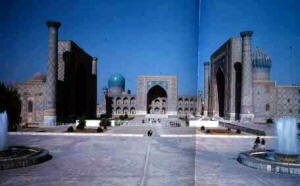 |
During centuries Registan Square was the center of Samarkand. The word Registan means “sand place”. There was a river running there many ages ago, before building the first Madrassah on the square. Years passed, the river dried out and left lots of sank there, that was the first place where the first Madrassah was built in the beginning of the 15th century and named Registan square. As the Madrassah was first built, all the holidays, parades, festivals and Sunday bazaars took place. |
|||||||||||||
| 8 | Sultan Ahmed Mosque (the Blue Mosque) in Istanbul, Turkey. | |||||||||||||
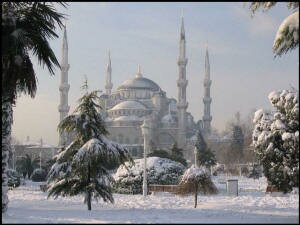 |
The Sultan Ahmed Mosque (Turkish: Sultanahmet Camii) is a historical mosque in Istanbul, the largest city in Turkey and was the capital of the Ottoman Empire (from 1453 to 1923). The mosque is one of several mosques known as the Blue Mosque for the blue tiles adorning the walls of its interior. It was built between 1609 and 1616, during the rule of Ahmed I. Like many other mosques, it also comprises a tomb of the founder, a madrasah and a hospice. The Sultan Ahmed Mosque has become one of the greatest tourist attractions of Istanbul. |
|||||||||||||
| 9 | Selimiye Mosque (Minar Sinan), built by Sinan in 1575. Edirne, Turkey. | |||||||||||||
 |
The Selimiye Mosque (Turkish: Selimiye Camii) is a mosque in the city of Edirne, Turkey. The mosque was commissioned by Sultan Selim II and was built by architect Mimar Sinan between 1568 and 1574. It was considered by Sinan to be his masterpiece and is one of the highest achievements of Islamic architecture. |
|||||||||||||
| 10 | The Great Mosque of Djenné in Mali (Timbuktu, Mali) | |||||||||||||
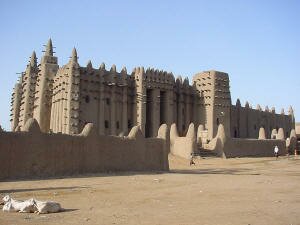 |
|
|||||||||||||